Diuretic Park 3: The Lost World
Summer 1997; 58 minutes; cast and crew of 29; approximate
cost of $150; rated PG-13.
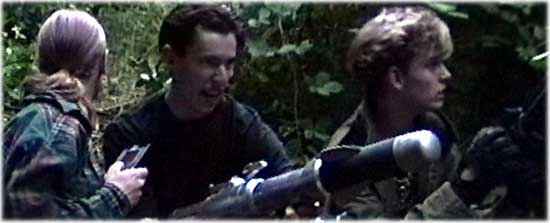
Synopsis
Excluding Fuzzywhumple Resurrection, this movie is
the biggest, most expensive, and most popular Tokugawa Picture
to date. The premise is simple: Isla Nublar (a.k.a. Diuretic
Park) was one of two islands where the dinosaurs lived. The
other island, called Isla Sorna or Site B, was actually the
place where the majority of the genetic engineering took place.
|
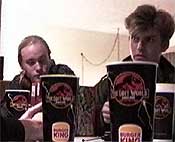
|
|
Like Isla Nublar, Site B rapidly lost all its human inhabitants,
and no one was left alive to tell its story. That is, until
six years later, when a dinosaur carcass washes up on the
coast of Rojas, Costa Rica, and a paleontologist names Levine
discovers the "lost world" from whence it came.
Levine isn't the only one to go to the island, however. He
is joined by chaotician Ian Malcolm, Ian's ex-girlfriend Sarah
Harding, Doc Thorne, and Eddie Carr. Their mission: study
the dinosaurs in their somewhat natural habitat and escape
with their lives.
|
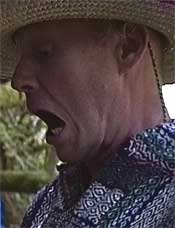 |
|
Seems easy enough, doesn't it? Not when Rossiter,
animal-exploiting leader of Byosin Corporation, finds out
about the island and sends a small but effective group of
goons to retrieve some dinosaur eggs and take care of any
opposition they might run into.
It only takes a quick glance at the previous
DP movies to guess that nearly everyone dies. Everyone, that
is, except Ian and Sarah, who are happily reunited in the
sappy ending sequence (see bottom of this page).
|
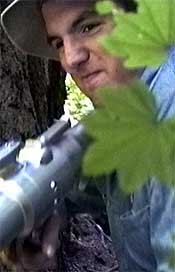 |
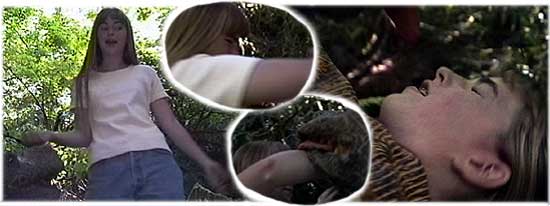
Influences
It doesn't take a brain surgeon to figure out that this movie
was influenced by the movie The Lost World: Jurassic Park
and, to an even greater extent, the book by Michael Crichton.
A large amount of the dialogue in DP3 has been lifted
directly out of the book--even more of Crichton's writing
can be seen here than in Spielberg's... um, shall we say interpretive...
rendition. (If anyone has read the book, this one has the
High Hide and the cylindrical cage and Lewis Dodgson!) Of
course, like the previous DP movies, this one also borrows
heavily from the great slapstick humor from Airplane
and The Naked Gun: Files from the Police Squad!, but
this one also borrows from Clear and Present Danger,
Aliens, and Austin Powers: International Man of
Mystery.
|
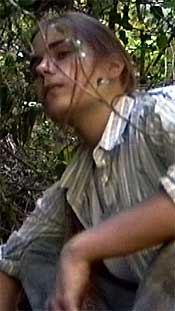 |

Method
Nothing really exceptionally new here save everything about
the movie was executed in a larger scale than previously.
For instance, sets were first constructed in The Escape, but
they were not as complex or expensive as the construction
of the High Hide and the Cage (which was large enough to fit
actor Clark Kirkman inside). Also, this movie has the largest
cast and crew so far, making it more "accessible"
to everyone. Thirdly, the locations in this movie were top-notch.
Filming was done in four cities spread across two states,
Oregon and California. The locations include Portland State
University (which is supposed to be the "Santa Fe Institute,"
Disneyland (represented in a nightmare sequence), and the
fecal coliform-filled Willamette River, in which Sarah and
Dodgson have it out. All this variety combined with the comparatively
large scale that this movie was produced on adds up to a colorful
and enjoyable movie.
|
Firsts
- Kendall McConnel and David Benjamin both experimented
with the cinematic aesthetics of water: Dodgson (Benjamin)
throws Sarah (McConnel) into the ocean during a storm, Sarah
meets a stegasaurus while half-submerged in water, Dodgson
meets a T-Rex after getting out of aforementioned water,
and Dodgson and Sarah fight in the muddy waste that gives
the Willamette Valley its name. The scenes were enjoyable,
in a masochistic sort of way, and looked fairly good.
- This is the first Tokugawa movie to implement the acting
skills of high school teachers (there are three in this
one, one of which is pictured on the right with a cigarette);
I have sought the same acting talents since, in Fuzzywhumple
Resurrection.
- The use of symbolism. This movie was not the first to
make use of a "Christ figure" (The Escape
was the first) but it was the first one to make use of religious
imagery. The spatial positions of actors around the stream
in a particular scene even symbolically represented their
moral and ethical standings (thanks to Kendall McConnel
for this last bit).
- Heavy advertising revolving mainly around one company:
Burger King... The Whopper™: "At just $1.39, these
tasty things can't be beat!"
|
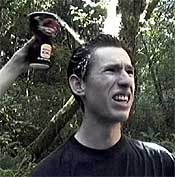
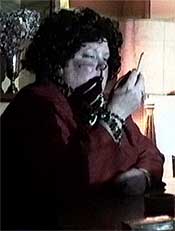
|
Lessons learned
- Speak loudly. This wasn't as much of a problem in this
movie as in some of the previous works, such as Love
or Jealousy, but there were a few goon scenes that left
a little to be desired in the area of sound quality. The
situation wasn't helped by the omnipresence of a running
stream throughout the ravine that served as Isla Sorna...
- No matter how intelligent and sophisticated the common
folk think they are, everyone always loves a good dollop
of immature humor. For instance, this movie had three instances
of homosexual undertones (in the forest and in the dance
scenes) in addition to jokes about dinosaur feces, dinosaurs
having sex, a clogged toilet, and a totally unnecessary
urination scene near the beginning.
|
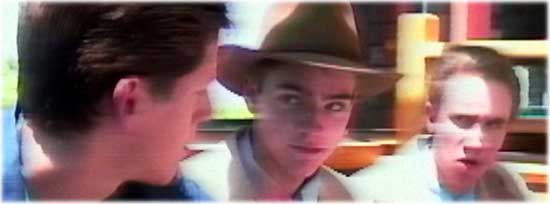
What people think
"I really like this movie. And I am in no way biased."
--David Benjamin
|
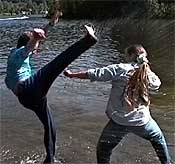 |

Downloads
|
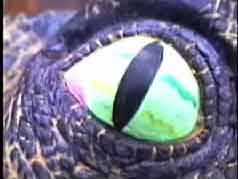 |
|